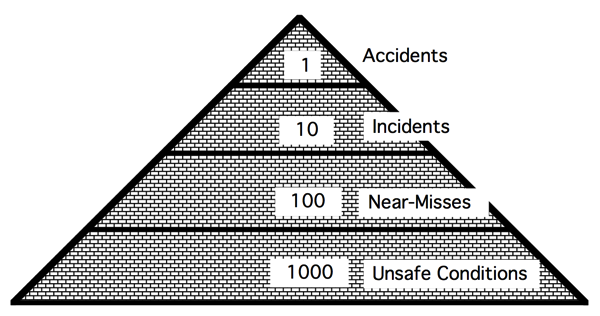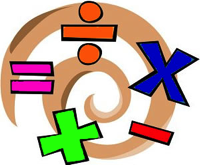Root Cause Analysis Tip: What is a corrective action worth? – A Gambler’s View of Corrective Actions (A Best of Article from the Root Cause Network™ Newsletter)
Adapted from the January 1995 Root Cause Network™ Newsletter, Copyright © 1995. Reprinted by permission. Some modifications have been made to update the article.
A GAMBLER’S VIEW OF CORRECTIVE ACTIONS
WHEN TO BET/WHEN TO FOLD
A winning gambler knows the odds. He knows that in the long run, he can beat the odds. Therefore, he looks for opportunities to bet more when the odds are in his favor. And when the odds are against him, he folds and waits for a better hand.
Preventing accidents is a numbers game. The pyramid blow provides a typical example of the ratio of accidents to incidents to near-misses to unsafe conditions.

In this pyramid, every incident must have the potential under slightly different circumstances to become the major accident at the top of the pyramid. Also, every near miss must have the potential to become an incident that could have become the top level accident. Finally, every unsafe condition could have caused a near-miss that could have become an incident that could have become the top level accident.
Thus, every unsafe act included at the bottom level of the pyramid must have the potential with the right set of circumstances to “cause” the top level accident.
The ratio above might not be exact. Your facility might be different. But we will use the ration of 1000 unsafe acts for every major accident as a starting point for out calculation of odds that we describe below.
The point is that every corrective action that fixes an unsafe condition has some odds of being the corrective action that could be preventing a major accident. Thus, we should try to understand the value NOT ONLY of the benefits that the corrective action immediately brings, BUT ALSO the reduction in the odds of a major accident that this corrective action provides.
THE COST OF A MAJOR ACCIDENT
To calculate the value of preventing a major accident, we need to calculate the potential cost of a major accident at your facility.
Of course, we don’t know the exact cost of the biggest accident (or even a typical major accident) that you face at your company. After all, they still don’t know what the cost of the Deepwater Horizon accident will be even after years of litigation. So, we have to make an educated guess that can be scaled to show how the cost could change.
For example, we might say that the cost a typical major accident would be $1,000,000,000.
Then, if you think your accident might be ten times worse (or ten times less), you can multiple or divide the results we calculate by 10.
ASSESSING THE ODDS
Why do we have to use “odds” to perform this calculation? Because you can’t tell exactly which unsafe condition will be related to your next major accident. We don’t know what corrective action that we implement today will prevent the next Deepwater Horizon, Three Mile Island, or Exxon Valdez type accident that costs billions of dollars. No one is that prescient. That’s why preventing major accidents is a numbers game. To prevent the next major accident you must reduce thousands of unsafe conditions.
Because the exact odds of any one unsafe act being a key factor in the next accident is unknowable, we assign equal potential to every unsafe condition that has potential to cause a major accident.
If the pyramid above represents your accident pyramid, then for every major accident, there are 1000 unsafe conditions that could contribute to it. Or another way to think about it is that we can’t predict the exact combination of factors that will cause the next major accident but if we do 1000 things to fix problems that could be involved in a major accident, we will stop one major accident.
Thus the odds that any one corrective action will stop a major accident is 1000 to 1.

CALCULATING THE VALUE OF A CORRECTIVE ACTION
I’ve seen people value corrective actions by using the value of the incident they would prevent.
For example, if the failure of a machine caused a delay that lost the company $100,000, the value of the corrective actions to prevent future failures would be $100,000. It’s never clear to me if this value should be divided between all of the corrective actions (for example, if there are 10 corrective actions, each would be worth, $10,000) or if each corrective action is worth $100,000. But the idea is that the corrective actions can be valued by the costs that will be saved from future similar incidents prevented.
What this equation leaves out is the value of an even worse accident that could also be prevented by the corrective actions.
Thus to calculate the value of a corrective action, you not only need to calculate the direct benefit, but also the amount that that corrective action contributed to the prevention of a major accident (if, indeed the corrective actions could help prevent a major accident).
But let’s stop here to correct misconceptions. A corrective action meant to stop paper cuts probably have very little value in preventing major accidents. Thus, we are not assigning severe accident risk to every corrective action. We would only assign the value to corrective actions that could help prevent major accidents.
The, the value of a corrective action is the direct cost that the corrective action saves us PLUS the value of the unknown major accident that it could prevent divided by the odds.
For example, if a corrective action saved us $10,000 in direct costs for a similar incident and if the value of a major accident at your facility is $1,000,000,000 and if we estimate that it will take correcting 1,000 unsafe acts to prevent the next accident, the value of our corrective action is…
VALUE = $10,000 + ($1,000,000,000/1000)
VALUE = $10,000 + $1,000,000
VALUE = $1,010,000
Thus valuing corrective action at their benefit for preventing a similar incident is UNDERVALUING the corrective actions.
And I believe we frequently undervaluing corrective actions.
Why?
Because we aren’t considering the value that a gambler sees. We are folding when we should be betting!
We should be investing much more in effective corrective actions thereby win by preventing the next major accident.

YOU CAN IMPROVE THE ODDS
There is even better news that can help you make the corrective actions you implement even more valuable (effective).
The TapRooT® Root Cause Analysis System can help you do a better job of analyzing potential problems and developing even more effective corrective actions for the root causes you uncover.
Think of TapRooT® as a luck rabbit’s foot that increases your odds of winning.
Of course, TapRooT® is much better than a lucky rabbit’s foot because instead of being built upon superstition, it is built upon proven human performance and equipment reliability technology that makes your investigators much more effective.
So don’t wait. Stop undervaluing your corrective actions and if you haven’t already started using TapRooT®, see our upcoming courses list, click on your continent, and get signed up for a course near you (or in a spot that you would like to visit).



